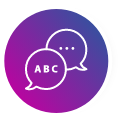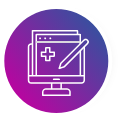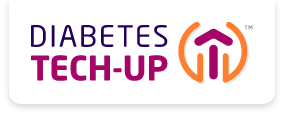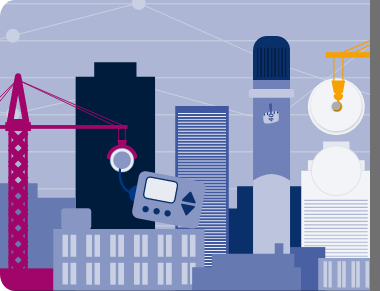How to help explain diabetes tech to anyone—regardless of their health literacy level
By Amy Hess-Fischl, MS, RDN, LDN, BC-ADM, CDCES
10 min read

When we talk about health literacy, I think we all know the deck is stacked against our patients. Back when I was in undergrad doing pre-med, I took an entire course focused on medical terminology—an entire course! That’s a full semester of studying to learn some of the most complex vocab in our language.
Now, think about how our patients must feel when we launch into a spiel about diabetes tech. Here are some tips to help you bridge health literacy gaps and have productive conversations about diabetes tech.
Making assessments in the moment
As a Certified Diabetes Care and Education Specialist (CDCES) who’s part of a recognized program, I assess every patient I see for their literacy and numeracy. Depending on your practice’s intake, you might not have that much information going into an appointment. Maybe all you know is someone’s highest level of education.
I’m here to tell you: That’s fine. Personally, I would rather know nothing the first time I meet with someone. The further I can get from preconceived notions, the faster I can get through to what the person in front of me needs.
When I meet with someone, I’m making an assessment in real time, starting the moment we both sit down. I begin with simple questions that can help us quickly find the right course for the conversation, like, “What medications are you taking? Why?” And then we go from there.

The further I can get from preconceived notions, the faster I can get through to what the person in front of me needs.
Staying level with health literacy
Even though I put conversations first, I still keep an eye on literacy trends and information in the US.
The National Library of Medicine defines personal health literacy as, “The degree to which individuals have the ability to find, understand, and use information and services to inform health-related decisions and actions for themselves and others.”1
Assessments might categorize someone’s health literacy using various scales. Regardless of how someone scores, there are a number of steps that health care professionals can take to present a more inclusive approach to all patients.
Guidelines for inclusive care

Use plain language2
Whenever possible, it’s good to avoid jargon when a commonly used word or phrase can get your point across to a patient. The Centers for Disease Control and Prevention (CDC) maintains an index of Everyday Words for Public Health Communication.
Whenever possible, it’s good to avoid jargon when a commonly used word or phrase can get your point across to a patient. The Centers for Disease Control and Prevention (CDC) maintains an index of Everyday Words for Public Health Communication.

Ensure patients have access to health information1
Providing access might involve offering both printed and online versions of health materials. These materials should also be available in a variety of languages, depending on the demographics of your community.
Providing access might involve offering both printed and online versions of health materials. These materials should also be available in a variety of languages, depending on the demographics of your community.

Review health materials with patients1
Some insurance forms and medication instructions are unavoidably technical. It’s important to check in with patients to ensure they understand materials like these and know what their next steps might be.
Some insurance forms and medication instructions are unavoidably technical. It’s important to check in with patients to ensure they understand materials like these and know what their next steps might be.
Understanding how a patient scores on a health literacy assessment can be helpful, but my approach to communication doesn’t differ based on their score. I’ve found that I have more success communicating with patients by getting to know them on a personal level.
As Harper Lee puts it in To Kill a Mockingbird, “You never really understand a person until you consider things from their point of view.” The more I listen to each patient, the better I understand how to support them.
Conversational tools and techniques
In my work, conversation is key to addressing the challenges that arise from low health literacy. No 2 conversations are the same because no 2 people are the same. However, there are still effective techniques that I like to use that help drive a discussion forward.
As you’re getting to know your patients, ask them how they like to learn. Some of these tools and techniques might lend themselves better to certain patients than others.

In my work, conversation is key to addressing the challenges that arise from low health literacy. No 2 conversations are the same because no 2 people are the same.
The teach-back method
One tool I use all the time is the teach-back method, a technique for confirming if a person understands the information I’m sharing with them.
How to apply the teach-back method3
Step 1
Explain the information using plain language and with a warm demeanor.
Step 2
Use open-ended questions to ask the patient to explain what you have discussed in their own words.
- “Now that we’ve talked about a continuous glucose monitor (CGM), what are some ways that it might help your diabetes management?”
- “How might an insulin pump help you with the issues you’ve been facing?”
- “Can you think of some ways this app might help you during your daily routine?”
Step 3
If the patient struggles to relay the information, ask them what areas they are having trouble with and revisit those parts of the conversation if they have more questions.
I can go on and on about CGMs this and automated insulin delivery (AID) that, but then I have to check and see what they heard me say. The teach-back method can give the patient the time they need to process what they’re hearing and help me make adjustments to how I’m delivering the information.3
Painting a picture with visual aids
When words aren’t getting the job done, there are good old visual aids.
Both the American Diabetes Association (ADA) and the Association of Diabetes Care and Education Specialists (ADCES) have a ton of great infographics to offer, especially when it comes to pumps and CGMs. I don’t use them all the time, but I like having them in my back pocket, even for virtual appointments. I keep a folder of these on my desktop that I can show via screenshare.
There are also ongoing efforts to create more engaging visual aids. The Ormskirk Diabetes Clinic over in the UK has developed a new model to use in place of the old “traffic light” style A1C charts. The Ormskirk Model uses neutral colors and patient-centric language to help clinicians and patients have a more positive discussion around A1C and time-in-range (TIR).4
But my favorite visual aid for explaining any piece of tech is the device itself. Nothing beats handing someone a CGM and showing them the different parts. I’ll say something like, “Ok, here’s the sensor, and here’s the wire that goes under the skin, and can you feel how light this is?”
We can have similar conversations about a pump or a connected insulin pen cap. I keep prop versions of these things on hand so I can pick it up and point at it and let the patient handle it. Just holding the device and seeing how it works can prompt questions that people haven’t thought to ask yet.
Problem-solving with parameters
Conversational tools and techniques can go a long way toward explaining tech to someone, and there’s a wealth of information and how-to content that helps, too. But some people still face challenges when trying to adopt new tech.
Often, I’ve found those challenges arise when my patients are trying to process all the data they’re suddenly presented with. Math and numbers are already challenging for many people, so it’s little wonder that a barrage of alerts from a CGM or another device can lead to alarm fatigue.5,6
It falls to us to try to simplify the information our patients need to process, and I can give you a shortcut: Not everyone needs to hear the Why.
For patients with high health literacy who are very engaged already, they might understand a new piece of tech in a snap. "Right, what's changing? OK, you're decreasing my basal insulin from .7 to .6 units because of X reason. Got it, makes sense."
On the opposite end, people who have lower health literacy may just need to know what’s changing. It can be helpful for them if I leave out the fine details and truncate their responsibilities. Specificity is important for helping people find their footing.
For example, one of my patients has a deep fear of hypoglycemia. Her A1C has consistently been around 9% or 10%. She's Type 1, wears a pump, and is clearly intelligent, but her fear of having a hypoglycemic episode can be enough to skew her perception.
The solution we've settled on is a set of specific parameters. I gave her an upper and a lower limit for her glucose levels, and we set alerts only for those two numbers. That way she knows how to course correct depending on what notification she gets from her CGM.

Math and numbers are already challenging for many people, so it’s little wonder that a barrage of alerts from a CGM or another device can lead to alarm fatigue.5,6 It falls to us to try to simplify the information our patients need to process.
The importance of taking a pause
No matter what kinds of challenges someone is facing, I think the key for us is to slow down and take the time to meet the patients where they are. Most of the primary care providers I talk to only get 15 to 20 minutes with their patients. That’s not a lot of time to absorb what could be a lot of new information.
In each appointment, I think it’s important to take a pause and make sure patients understand. If someone is overwhelmed, it might be a good opportunity to use a technique like the teach-back method discussed above.
When we take the time to understand what patients are going through and let them process what they have learned, that can help them stay open to tech, which might have a big impact on their diabetes management.7,8
Crossing barriers and building bridges
Language barriers are a different kind of communication challenge, but my approach is still centered on building personal connections.
I'm lucky—my program can bring in translators when there's a language barrier, but I'm picky about those translators. Just like it’s important to connect with the person I’m seeing, I think a translator also needs to feel a connection with my patient.
Ideally, I'm talking to a family member. There's one patient I see all the time who only speaks Greek, and his daughter is our interpreter. She’s with us for every appointment and when he sends me his data, I CC her with updates to our plan.
Language isn’t the only gap we can encounter. Different cultures also require different considerations. For health care professionals, cultural awareness is another kind of ongoing skills training that we have to keep up with in order to meet the needs of our patients.
An example that’s always relevant for people with diabetes: Holidays. Different cultures celebrate at different times of year and in different ways. Not everyone is trying to figure out how to navigate Thanksgiving dinner. You might have patients who observe traditions by fasting, so that’s a different conversation than you might be used to.
The CDC offers resources that can help clinicians better understand other cultures through modules and case studies. But the onus is ultimately on us to seek out and appreciate other perspectives.

Health care professionals can bridge health literacy gaps using the building blocks of empathy, preparation, and patience.
Collaborating on patient education
As clinicians, if we don’t keep health literacy top of mind, there’s a chance it will directly affect outcomes for our patients.9
The challenge of meeting patients where they are is a lot to ask any one clinician to overcome, so I want to recommend a collaborative approach. The ADCES has a tool to look up accredited diabetes education programs, and I encourage you to explore options in your area that might be available to your patients.
My hope is that by working together, we can make strides to get everyone on the same page and move the conversation around diabetes tech forward.
Tech-up Follow-ups
- Plan to use a communication technique, such as teach-back, in your next conversation with a patient who has lower health literacy.
- Explore available resources or ongoing education that can help strengthen your cultural awareness.
- Reach out to a CDCES or diabetes education program in your area and ask about opportunities to refer patients.

Amy Hess-Fischl, MS, RDN, LDN, BC-ADM, CDCES
Chicago, Illinois
Amy is a diabetes care and education specialist and registered dietitian who sees type 1 and type 2 diabetes patients daily. She oversees their education recognition program and coordinates the Teen and Adolescent Diabetes Transition Program at University of Chicago’s Kovler Diabetes Center. She received the American Diabetes Association’s Outstanding Educator of the Year award in 2022.
Amy Hess-Fischl received a fee from Novo Nordisk for her participation.
References
- An introduction to health literacy. nnlm.gov. Last updated October 4, 2023. Accessed February 2024. https://www.nnlm.gov/guides/intro-health-literacy
- What is health literacy? CDC.gov. Last reviewed July 11, 2023. Accessed February 2024. https://www.cdc.gov/healthliteracy/learn/index.html
- 10 Elements of Competence for Using Teach-back Effectively (PDF). Institute for Healthcare Advancement. 2023. Accessed February 2024. https://higherlogicdownload.s3.amazonaws.com/HEALTHLITERACYSOLUTIONS/b33097fb-8e0f-4f8c-b23c-543f80c39ff3/UploadedImages/docs/Teach_Back_-_10_Elements_of_Competence.pdf
- Guyers M, Bray D, Ng SM. Language matters; image matters too. The Ormskirk Model: a new HbA1c–time-in range solution-focused model. Diabetes Care for Children & Young People. 2020;9(2): 1-4. Accessed March 12, 2024. https://diabetesonthenet.com/wp-content/uploads/pdf/dotn83668ddc419adf1471e15e6666fe3c9e.pdf
- National Center for Education Statistics. International comparisons of adult literacy and numeracy skills over time. Data Point. 2021.
- Shivers JP, Mackowiak L, Anhalt H, Zisser H. "Turn it off!": diabetes device alarm fatigue considerations for the present and the future. J Diabetes Sci Technol. 2013;7(3):789-794. doi:10.1177/193229681300700324
- Swanson V, Maltinsky W. Motivational and behaviour change approaches for improving diabetes management. Practical Diabetes. 2019; 36(4): 121-125.
- Patil SP, Albanese-O'Neill A, Yehl K, Seley JJ, Hughes AS. Professional competencies for diabetes technology use in the care setting. Sci Diabetes Self Manag Care. 2022;48(5):437-445. doi:10.1177/26350106221120889
- Vandenbosch J, Van den Broucke S, Schinckus L, et al. The impact of health literacy on diabetes self-management education. Health Education Journal. 2018;77(3):349-362. doi:10.1177/0017896917751554
The Diabetes Tech-upTM Podcast
Join our expert cohosts for a series of discussions about how they’re integrating diabetes tech with patient-centered care to help optimize diabetes management.
The Mission of Diabetes Tech-upTM
Diabetes Tech-upTM is sponsored by Novo Nordisk, a global leader in diabetes. We believe that adoption of innovative technologies can help appropriate patients better manage diabetes. Our goal is to provide information to help health care professionals on the front line of diabetes care strengthen their understanding of diabetes technologies and implement them where they can have the greatest impact.




Share: